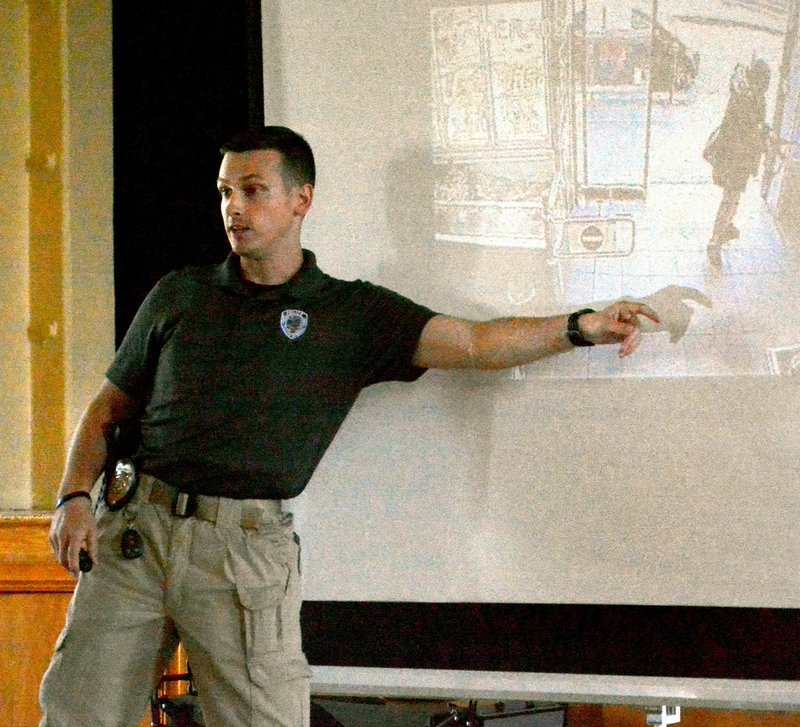Empowering community members to act to protect themselves or others in the case of an active shooter or killer was the focus of a training session sponsored by the Siloam Springs Chamber of Commerce and Police Department.
About 50 people attended the two-hour training seminar at the Community Building on Monday night. The training was targeted toward the general public, as well as local business and non-profit leaders.
Officer Josh Fritz, of the Siloam Springs Police Department, led the training session. Fritz has led other training sessions for schools and recently completed several training courses himself, according to Police Chief Jim Wilmeth. Monday's session followed the advice of the Advanced Law Enforcement Rapid Response Training (ALERRT) Center at Texas State University to avoid the attacker, deny the attacker to the area and defend oneself.
Between 2000 and 2015, a total of 242 incidences of attempted mass murder -- with guns, bombs, vehicles, knives or other weapons -- took place in the United States, Fritz said. More than 50 percent of the attacks were on businesses, while around 25 percent were on places of education, which include schools in session, school board meetings and school related sporting events. An additional 12 percent took place outdoors, and about 10 percent took place in other locations, he said.
Two major factors play into the number of survivors in an attack -- law enforcement response and target availability, Fritz said. The average officer response time is three minutes, but a lot can happen during that time, he said.
When people are faced with an emergency situation, they go through three stages of response, Fritz said. The first stage is denial. For example, people may discount gunfire as fireworks or other sounds because it seems like the most normal explanation. Second is deliberation, or the time it takes to make a choice of how to act. The final stage is to take action.
Social bias is another factor in reacting to an emergency, Fritz said. People tend to do whatever everyone around them is doing so if nobody else is reacting, people are less likely to react themselves, he said.
During times of high stress, people react with the most primitive part of their brain, or their lizard brain, Fritz said. People can train this part of the brain to react in a certain way by going over scripts in their mind of the correct way to react in certain situations, he said. Fritz also shared several calming and breathing techniques to help prevent complete panic.
It is important for people to be aware of their surroundings at all times as well as of the exits of buildings they are in, Fritz said.
No matter the situation, it is always better to be proactive than to freeze, he said. In the event of an attack, he encouraged people to avoid the attacker by quickly leaving the area, to deny the attacker entrance to where they are by locking or barricading doors and to defend themselves if they so choose.
Wayne Mays, president and CEO of the Chamber of Commerce, noted that active shooter incidents happen in large, medium and small cities.
"We hope what happens tonight is that you or someone that you take this information to is ready if a situation like this arises and you know what to do, and you do the right thing and save some lives," he said.
Wilmeth said the point of the training was to empower citizens. While the police department wants to partner with the community to provide protection, if there were enough officers to protect every single person, the U.S. would be a police state instead of a republic, he said.
"We want you to be empowered because we can't always be where we need to be when we need to be there," he said. "A lot of times, it may be one of you, and if its one of you that have the opportunity to save somebody's life, then this training has absolutely been worth it."
The Siloam Springs Police Department offers a program called Project Stronghold, where officers will come to a business or home and do a threat assessment, then offer suggestions of ways to protect people and property, Wilmeth said.
Violent criminals are often predators and look for a weak place to strike, he said.
"So one of the things we want to do is provide you all with some training and some knowledge to help prepare you if a predator decides to go somewhere where you are at," he said.
General News on 07/25/2018
